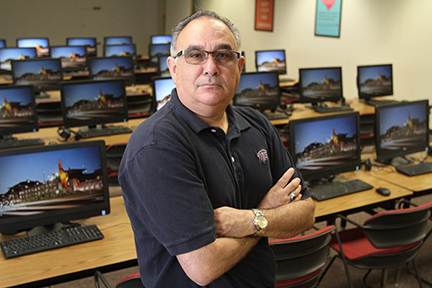Originally published May 8, 2015
By Daniel Perez
UTEP News Service
Social media is a great way for family and friends to stay connected, but recent research conducted by The University of Texas at El Paso shed light on how transnational criminal elements exploit it.
In May 2014, the U.S. Department of Homeland Security’s Science and Technology Directorate commissioned UTEP’s National Center for Border Security and Immigration (NCBSI) to research the levels to which organized crime used social networks. The research was for Homeland Security Investigations El Paso, an agency under the umbrella of U.S. Immigration and Customs Enforcement.

The NCBSI hired six graduate students in UTEP’s Intelligence and National Security Studies program and an undergraduate criminal justice major to collect open source data from August through November 2014 using public social media sites including Facebook.
Victor M. Manjarrez Jr., NCBSI associate director, and others who were part of the project shared the results with Immigration and Customs Enforcement officials in March 2015. The research showed a sizeable use of that social network to engage in illegal commerce involving sex, drugs and guns.
“It was pretty darn amazing how forthright the criminal organizations were on Facebook,” Manjarrez said with an incredulous chuckle. “There was an incredible amount of sites and they were as blatant as you could imagine. We were surprised at the volume.”
The process was as important as the results to Manjarrez, a former U.S. Border Patrol sector chief, who saw this exercise as a learning opportunity for the UTEP students to gain valuable real-world intelligence gathering experience. He did not name the student researchers to protect their identities.
NCBSI worked with Immigration and Customs Enforcement to develop the scope of the research and then created the project’s methodology based on policies set up by Facebook, such as no deceptive identities, and UTEP’s Institutional Review Board.
The students were set up on different ambiguous social media group accounts on the public pages that protected the identities of the students and the University. ICE agents gave the students an orientation and suggested some English and Spanish keyword searches to start their investigation. The data snowballed from there. In some cases, the suspect sites contacted the student group with an invitation to “friend” them. The students ignored the invitations.
During their research, the students found that certain media platforms such as Facebook were used more than others. Manjarrez described the kinds of things that the students found on the public sites from both sides of the U.S.-Mexico border, such as photos of people with recognizable backgrounds, cars with visible license plates, gang symbols, phone numbers and photos of drivers’ licenses, along with automatic weapons and bundles of what appeared to be marijuana. Sometimes there were solicitations for drivers or for buyers.
Students documented the visual and/or written cues, but did not pass along the subjects’ personal identifiers because the researchers were barred from acting on behalf of law enforcement.
Coded case files were set up by Victor Talavera, NCBSI program manager and project principal investigator. Talavera and another student translated the Spanish information and verified each other’s work.
Larry Valero, Ph.D., director of UTEP’s National Security Studies Institute, said knowing how to navigate social media has become important for security analysts because it is one of the more common communications methods used by terrorist and criminal organizations.
Valero added that law enforcement and national defense agencies covet multilingual critical thinkers such as those produced by UTEP who can collect, verify and analyze data from different social media platforms.
“This kind of real-world experience helps the students with their marketability,” Valero said. “It will mean a lot when they enter the job market. Being part of something like this is what future employers want to see.”
The center’s findings were sent to a criminal justice doctoral student from South Carolina who had done social media work for other law enforcement agencies. He compiled the data and created a link analysis that followed the “friends” of suspects to form a network. The doctoral student also did a qualitative analysis of the subjects’ text messages.
Waldemar Rodriguez, Homeland Security Investigations El Paso special agent in charge, said his group is fortunate to have a working relationship with NCBSI. In an email interview, he said the center’s research during the past three years has helped the Homeland Security Investigations to sharpen its approach, especially in social media. It also helped the organization to become more effective in its investigations of transnational criminal activity.
“We were impressed with the level of research, insight and effort that NCBSI placed on its projects, and found the research to be useful and relevant,” Rodriguez said, adding that Homeland Security Investigations El Paso looked forward to additional collaborations.
As is the normal protocol, the raw data has been destroyed and the University’s Information Technology department has wiped the hard drives of the computers involved.